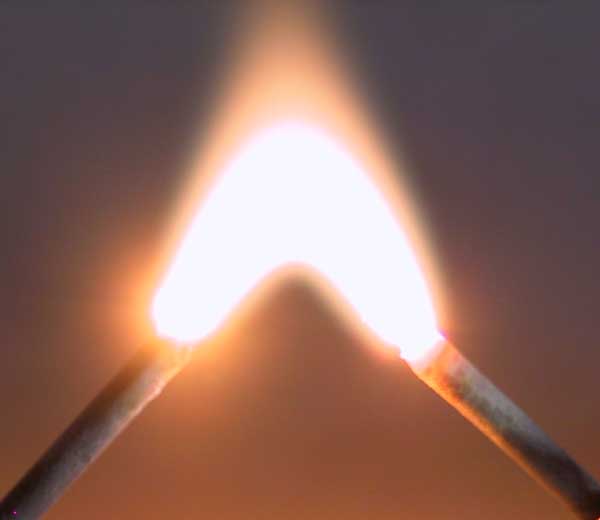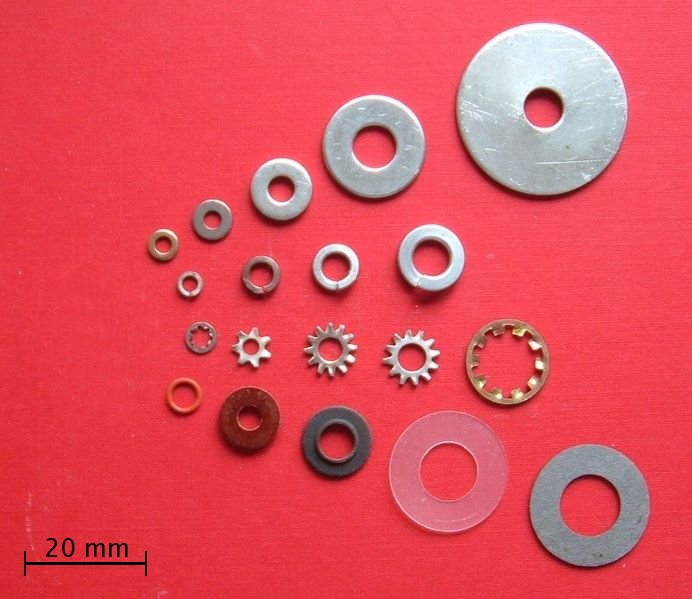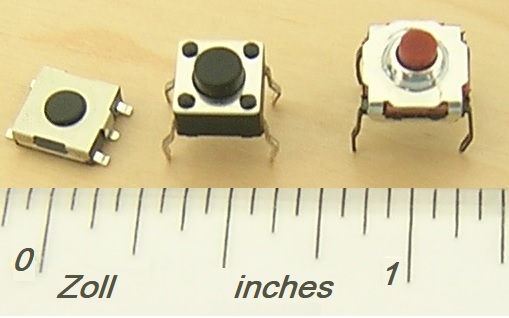|
NEMA FR-4
FR-4 (or FR4) is a NEMA grade designation for glass-reinforced epoxy laminate material. FR-4 is a composite material composed of woven fiberglass cloth with an epoxy resin binder that is flame resistant (''self-extinguishing''). "FR" stands for "flame retardant", and does not denote that the material complies with the standard UL94V-0 unless testing is performed to UL 94, Vertical Flame testing in Section 8 at a compliant lab. The designation FR-4 was created by NEMA in 1968. FR-4 glass epoxy is a popular and versatile high-pressure thermoset plastic laminate grade with good strength to weight ratios. With near zero water absorption, FR-4 is most commonly used as an electrical insulator possessing considerable mechanical strength. The material is known to retain its high mechanical values and electrical insulating qualities in both dry and humid conditions. These attributes, along with good fabrication characteristics, lend utility to this grade for a wide variety of electrica ... [...More Info...] [...Related Items...] OR: [Wikipedia] [Google] [Baidu] |
National Electrical Manufacturers Association
The National Electrical Manufacturers Association (NEMA) is the largest trade association of electrical equipment manufacturers in the United States. Founded in 1926, it advocates for the industry and publishes standards for electrical products. Notably, the form of US household electrical outlets and plugs is specified by NEMA. Description It was founded in 1926 and maintains its headquarters in Rosslyn, Virginia, in the Washington metropolitan area. Its approximately 350 member companies manufacture products used in the generation, transmission, distribution, control, and end use of electricity. These products are used in utility, industrial, commercial, institutional, and residential applications. The association's Medical Imaging and Technology Alliance (MITA) division represents manufacturers of cutting-edge medical diagnostic imaging equipment including MRI, CT, x-ray, and ultrasound products. Other major end markets include building systems, electrical infrastructur ... [...More Info...] [...Related Items...] OR: [Wikipedia] [Google] [Baidu] |
Printed Circuit Board
A printed circuit board (PCB), also called printed wiring board (PWB), is a Lamination, laminated sandwich structure of electrical conduction, conductive and Insulator (electricity), insulating layers, each with a pattern of traces, planes and other features (similar to wires on a flat surface) Chemical milling, etched from one or more sheet layers of copper laminated onto or between sheet layers of a non-conductive substrate. PCBs are used to connect or Electrical wiring, "wire" Electronic component, components to one another in an electronic circuit. Electrical components may be fixed to conductive pads on the outer layers, generally by soldering, which both electrically connects and mechanically fastens the components to the board. Another manufacturing process adds Via (electronics), vias, metal-lined drilled holes that enable electrical interconnections between conductive layers, to boards with more than a single side. Printed circuit boards are used in nearly all e ... [...More Info...] [...Related Items...] OR: [Wikipedia] [Google] [Baidu] |
Polyimide
Polyimide (sometimes abbreviated PI) is a monomer containing imide groups belonging to the class of high-performance plastics. With their high heat-resistance, polyimides enjoy diverse applications in roles demanding rugged organic materials, such as high temperature fuel cells, displays, and various military roles. A classic polyimide is Kapton, which is produced by condensation of pyromellitic dianhydride and 4,4'-oxydianiline.Wright, Walter W. and Hallden-Abberton, Michael (2002) "Polyimides" in ''Ullmann's Encyclopedia of Industrial Chemistry'', Wiley-VCH, Weinheim. History The first polyimide was discovered in 1908 by Bogart and Renshaw. They found that 4-amino phthalic anhydride does not melt when heated but does release water upon the formation of a high molecular weight polyimide. The first semialiphatic polyimide was prepared by Edward and Robinson by melt fusion of diamines and tetra acids or diamines and diacids/diester. However, the first polyimide of significant co ... [...More Info...] [...Related Items...] OR: [Wikipedia] [Google] [Baidu] |
FR-2
FR-2 (Flame Resistant 2) is a NEMA designation for synthetic resin bonded paper, a composite material made of paper impregnated with a plasticized phenol formaldehyde resin, used in the manufacture of printed circuit boards. Its main properties are similar to NEMA grade XXXP (MIL-P-3115) material, and can be substituted for the latter in many applications. Applications FR-2 sheet with copper foil lamination on one or both sides is widely used to build low-end consumer electronics equipment. While its electrical and mechanical properties are inferior to those of epoxy-bonded fiberglass, FR-4, it is significantly cheaper. It is not suitable for devices installed in vehicles, as continuous vibration can make cracks propagate, causing hairline fractures in copper circuit traces. Without copper foil lamination, FR-2 is sometimes used for simple structural shapes and electrical insulation. Properties Fabrication FR-2 can be machined by drilling, sawing, milling and hot punchi ... [...More Info...] [...Related Items...] OR: [Wikipedia] [Google] [Baidu] |
Screw Terminal
A screw terminal is a type of terminal (electronics), electrical connection where a wire is held by the tightening of a screw. Description The wire may be wrapped directly under the head of a screw, may be held by a metal plate forced against the wire by a screw, or may be held by what is, in effect, a set screw in the side of a metal tube. The wire may be directly stripped of insulation and inserted under the head of a screw or into the terminal. Otherwise, it may be either inserted first into a ferrule, which is then inserted into the terminal, or else attached to a connecting lug, which is then fixed under the screw head. Depending on the design, a flat-blade screwdriver, a cross-blade screwdriver, hex key, Torx key, or other tool may be required to properly tighten the connection for reliable operation. Applications Screw terminals are used extensively in building wiring for the distribution of electricity - connecting electrical outlets, Light fixture, luminaires and ... [...More Info...] [...Related Items...] OR: [Wikipedia] [Google] [Baidu] |
Transformer
In electrical engineering, a transformer is a passive component that transfers electrical energy from one electrical circuit to another circuit, or multiple Electrical network, circuits. A varying current in any coil of the transformer produces a varying magnetic flux in the transformer's core, which induces a varying electromotive force, electromotive force (EMF) across any other coils wound around the same core. Electrical energy can be transferred between separate coils without a metallic (conductive) connection between the two circuits. Faraday's law of induction, discovered in 1831, describes the induced voltage effect in any coil due to a changing magnetic flux encircled by the coil. Transformers are used to change Alternating current, AC voltage levels, such transformers being termed step-up or step-down type to increase or decrease voltage level, respectively. Transformers can also be used to provide galvanic isolation between circuits as well as to couple stages of signa ... [...More Info...] [...Related Items...] OR: [Wikipedia] [Google] [Baidu] |
Electric Arc
An electric arc (or arc discharge) is an electrical breakdown of a gas that produces a prolonged electrical discharge. The electric current, current through a normally Electrical conductance, nonconductive medium such as air produces a plasma (physics), plasma, which may produce visible light. An arc discharge is initiated either by thermionic emission or by field emission. After initiation, the arc relies on thermionic emission of electrons from the electrodes supporting the arc. An arc discharge is characterized by a lower voltage than a glow discharge. An archaic term is voltaic arc, as used in the phrase "voltaic arc lamp". Techniques for arc suppression can be used to reduce the duration or likelihood of arc formation. In the late 19th century, Arc lamp, electric arc lighting was in wide use for Street light#Arc lamps, public lighting. Some low-pressure electric arcs are used in many applications. For example, fluorescent lamp, fluorescent tubes, mercury, sodium, and met ... [...More Info...] [...Related Items...] OR: [Wikipedia] [Google] [Baidu] |
Washer (hardware)
A washer is a thin plate (typically disk-shaped, but sometimes square) with a hole (typically in the middle) that is normally used to distribute the load of a threaded fastener, such as a Bolt (fastener), bolt or Nut (hardware), nut. Other uses are as a spacer, spring (Belleville washer, wave washer), wear pad, preload (engineering), preload indicating device, locking device, and to reduce vibration (rubber washer). Washers are usually metal or plastic. High-quality bolted joints require hardened steel washers to prevent the loss of pre-load due to brinelling after the torque is applied. Washers are also important for preventing galvanic corrosion, particularly by insulating steel screws from aluminium surfaces. They may also be used in rotating applications, as a bearing. A ''thrust washer'' is used when a rolling element bearing is not needed either from a cost-performance perspective or due to space restraints. Coatings can be used to reduce wear and friction, either by hardeni ... [...More Info...] [...Related Items...] OR: [Wikipedia] [Google] [Baidu] |
Busbar
In electric power distribution, a busbar (also bus bar) is a metallic strip or bar, typically housed inside switchgear, panel boards, and busway enclosures for local high current power distribution. They are also used to connect high voltage equipment at electrical switchyards, and low-voltage equipment in battery banks. They are generally uninsulated, and have sufficient stiffness to be supported in air by insulated pillars. Those features allow sufficient cooling of the conductors, and the ability to tap in at various points without having to create a new joint. Design and placement The busbar's material composition and cross-sectional size determine the maximum current it can safely carry. Busbars can have a cross-sectional area of as little as , but electrical substations may use metal tubes in diameter or more as busbars. Aluminium smelters use very large busbars to carry tens of thousands of amperes to the electrochemical cells that produce aluminium from molten ... [...More Info...] [...Related Items...] OR: [Wikipedia] [Google] [Baidu] |
Standoff (separator)
In general, a spacer is a solid material used to separate two parts in an assembly. Spacers can vary in size from microns to centimeters. They can be made of metal, plastic, glass, and other materials. Shapes include flat sheet, cylindrical and spherical. A standoff is a threaded separator of defined length used to raise one part in an assembly above another. They are usually round or hex (for wrench tightening), often made of stainless steel, aluminum, brass, or nylon, and come in male-female or female-female forms. In electronics they are frequently used to raise a printed-circuit board above a surface. Insulating standoffs keep two parts from touching each other, thereby preventing electrical shorts. In some cases (e.g., D-subminiature connectors), short standoffs may be used to receive the Jackscrew#In electronic connectors, jackscrews that lock the connection together. In contrast, some spacers may look similar to standoffs but are unthreaded pieces of tubing which let the e ... [...More Info...] [...Related Items...] OR: [Wikipedia] [Google] [Baidu] |
Switch
In electrical engineering, a switch is an electrical component that can disconnect or connect the conducting path in an electrical circuit, interrupting the electric current or diverting it from one conductor to another. The most common type of switch is an electromechanical device consisting of one or more sets of movable electrical contacts connected to external circuits. When a pair of contacts is touching current can pass between them, while when the contacts are separated no current can flow. Switches are made in many different configurations; they may have multiple sets of contacts controlled by the same knob or actuator, and the contacts may operate simultaneously, sequentially, or alternately. A switch may be operated manually, for example, a light switch or a keyboard button, or may function as a sensing element to sense the position of a machine part, liquid level, pressure, or temperature, such as a thermostat. Many specialized forms exist, such as the toggle swit ... [...More Info...] [...Related Items...] OR: [Wikipedia] [Google] [Baidu] |
Relay
A relay Electromechanical relay schematic showing a control coil, four pairs of normally open and one pair of normally closed contacts An automotive-style miniature relay with the dust cover taken off A relay is an electrically operated switch. It has a set of input terminals for one or more control signals, and a set of operating contact terminals. The switch may have any number of contacts in multiple contact forms, such as make contacts, break contacts, or combinations thereof. Relays are used to control a circuit by an independent low-power signal and to control several circuits by one signal. They were first used in long-distance telegraph circuits as signal repeaters that transmit a refreshed copy of the incoming signal onto another circuit. Relays were used extensively in telephone exchanges and early computers to perform logical operations. The traditional electromechanical relay uses an electromagnet to close or open the contacts, but relays using other operati ... [...More Info...] [...Related Items...] OR: [Wikipedia] [Google] [Baidu] |






